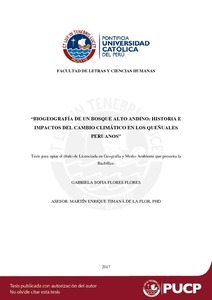| dc.contributor.advisor | Timaná de la Flor, Martín Enrique | es_ES |
| dc.contributor.author | Flores Flores, Gabriela Sofía | es_ES |
| dc.date.accessioned | 2017-07-17T20:58:25Z | es_ES |
| dc.date.available | 2017-07-17T20:58:25Z | es_ES |
| dc.date.created | 2017 | es_ES |
| dc.date.issued | 2017-07-17 | es_ES |
| dc.identifier.uri | http://hdl.handle.net/20.500.12404/9057 | |
| dc.description.abstract | Las zonas alto andinas del Perú son el hábitat del género Polylepis, un grupo arbóreo de alta
relevancia ecológica que concentra una alta diversidad de especies y que es una fuente de
distintos servicios ecosistémicos. Desde tiempos antiguos su distribución viene siendo
afectada por las actividades del ser humano, por lo que en la actualidad su distribución se ha
visto reducida a pequeños rodales. En un futuro, debido al cambio climático, su extensión
actual podría disminuir.
Este proyecto de investigación tuvo como objetivo principal el determinar la distribución de
cuatro especies de Polylepis (P. weberbaueri, P. sericea, P. incana y P. racemosa), así como
del género, en los Andes centrales del Perú. Se determinaron las distribuciones actuales de
las especies mediante la recopilación y georreferenciación de colecciones botánicas
realizadas en el Perú. A partir de ello, se generó un Modelo de Distribución de Especies a
tiempo pasado, presente y futuro, aplicando distintas variables climáticas y con diferentes
modelos climáticos globales mediante el software Maxent. Finalmente, se hallaron y
analizaron los lugares potencialmente más aptos para la ocurrencia de las especies y el
género Polylepis en un escenario presente, pasado y futuro, teniendo en cuenta los factores
que han influido en la distribución del género a lo largo del tiempo. | es_ES |
| dc.description.abstract | The high Andean areas of Peru are the habitat of the genus Polylepis, an arboreal group of
high ecological relevance that concentrates a high diversity of species and that is a source of
different ecosystem services. Since ancient times its distribution has been affected by human
activities, reason why at the moment its distribution has been reduced to small patches. In
the future, due to climate change, its current extent could decrease.
This research project had as main objective to determine the distribution of four species of
Polylepis (P. weberbaueri, P. sericea, P. incana and P. racemosa), as well as of the genus,
in the central Andes of Peru. The current distributions of the species were determined
through the collection and georeferentiation of botanical collections in Peru. From this, a
Model of Distribution of Species was generated at past, present and future time, applying
different climatic variables with different global climate models through Maxent software.
Finally, the sites potentially most suitable for the occurrence of the species and the genus
Polylepis were found and analyzed in a present, past and future scenario, taking into account
the factors that have influenced the distribution of the genus over time. | es_ES |
| dc.language.iso | spa | es_ES |
| dc.publisher | Pontificia Universidad Católica del Perú | es_ES |
| dc.rights | info:eu-repo/semantics/openAccess | es_ES |
| dc.rights.uri | http://creativecommons.org/licenses/by/2.5/pe/ | * |
| dc.subject | Bosques--Cambio climático--Perú | es_ES |
| dc.subject | Recursos forestales--Biogeografía--Perú--Andes, Región | es_ES |
| dc.title | "Biogeografía de un bosque alto andino : historia e impactos del cambio climático en los queñuales peruanos" | es_ES |
| dc.type | info:eu-repo/semantics/bachelorThesis | es_ES |
| thesis.degree.name | Licenciado en Geografía y Medio Ambiente | es_ES |
| thesis.degree.level | Título Profesional | es_ES |
| thesis.degree.grantor | Pontificia Universidad Católica del Perú. Facultad de Letras y Ciencias Humanas | es_ES |
| thesis.degree.discipline | Geografía y Medio Ambiente | es_ES |
| renati.discipline | 532036 | es_ES |
| renati.level | https://purl.org/pe-repo/renati/level#tituloProfesional | es_ES |
| renati.type | http://purl.org/pe-repo/renati/type#tesis | es_ES |
| dc.publisher.country | PE | es_ES |
| dc.subject.ocde | https://purl.org/pe-repo/ocde/ford#5.07.00 | es_ES |






